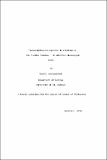Files in this item
Transcription in amphibia in relation to the C-value Paradox : an electron microscopic study
Item metadata
| dc.contributor.advisor | Callan, Harold Garnet | |
| dc.contributor.author | Narayanswami, Sandya | |
| dc.coverage.spatial | 2 vol. | en_US |
| dc.date.accessioned | 2018-06-08T15:14:15Z | |
| dc.date.available | 2018-06-08T15:14:15Z | |
| dc.date.issued | 1979 | |
| dc.identifier.uri | https://hdl.handle.net/10023/13859 | |
| dc.description.abstract | CHAPTER I. The ultrastructure of transcription in cultured cells of T.c. carnifea was compared with, that of cultured cells from X. laevis using the "Miller spreading technique". Primary RHA transcripts of nonribosomal origin, up to 10 mum in length, and arranged in long transcription complexes were observed in T.c. camifex; whereas the maximum length of primary transcripts in S. laevis was about 2 mum. In both cell lines transcription was sparse and predominantly visualised as isolated RNP fibrils. CHAPTER II. Patterns of transcription in liver cells of X, laevis. T.c. carnifex and N. maculosus were compared, using the "Miller" technique. Chromatin had a nucleosomal structure and transcription complexes occurred on beaded chromatin. N. maculosus with the largest C-value (52 pg) synthesised the longest primary transcripts. Transcription complexes of two or more RNP fibrils were rare in the chromatin of these species. The percentages of different types of transcription complex (l RNP fibril, 2 RNP fibrils, 3 or more RNP fibrils) were similar for the three species. CHAPTER III. The ultrastructure of transcription in T.c. carnifex neurula cells was investigated, using the Miller technique. Transcription occurred predominantly in the form of isolated RNP fibrils whose median length was greater than for T.c. carnifex liver cells or cultured cells, in that order. The percentage of transcription complexes of two or more RNP fibrils was greater in T.c. carnifex liver (33.8%) than in T.c. carnifex embryos (17.3%). CHAPTER IV. The Miller technique was used to investigate the ultrastructure of transcription in X. laevis and T.c. carnifex' culture cells treated with cortisol or thyrozine. After cortisol treatment of X. laevis the median lengths of isolated nonrihosomal RNA fibrils, and the terminal fibrils of multifibril complexes, increased twofold, as did the percentage of multifibril transcription completes (from 5.6% to 28.1%), The DNA packing ratio of transcriptionally inactive regions of the chromatin was slightly less than that of untreated cells spread under the same conditions. There was also a decrease in the DNA packing ratio of transcriptionally active regions of the chromatin of treated cells as compared to the value for inactive regions. The results were inconclusive but were not sufficient to eliminate the possibility that an increase in the amount of transcription causes an increase in the size of the nucleus. The results were similarly inconclusive for T.c. carnifex cultured cells treated with cortisol. (Abstract shortened by ProQuest.) | en_US |
| dc.language.iso | en | en_US |
| dc.publisher | University of St Andrews | |
| dc.subject.lcc | QH450.2N2 | en |
| dc.subject.lcsh | Genetic transcription | en |
| dc.title | Transcription in amphibia in relation to the C-value Paradox : an electron microscopic study | en_US |
| dc.type | Thesis | en_US |
| dc.contributor.sponsor | Science Research Council (Great Britain) | en_US |
| dc.type.qualificationlevel | Doctoral | en_US |
| dc.type.qualificationname | PhD Doctor of Philosophy | en_US |
| dc.publisher.institution | The University of St Andrews | en_US |
This item appears in the following Collection(s)
Items in the St Andrews Research Repository are protected by copyright, with all rights reserved, unless otherwise indicated.

